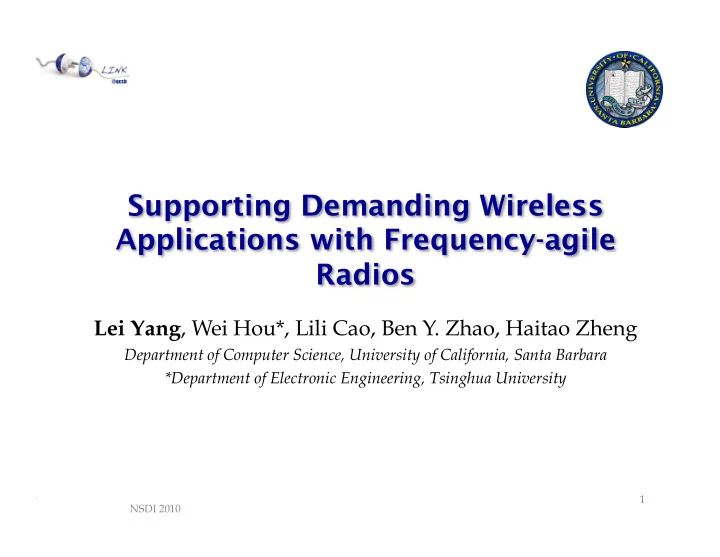

Supporting Demanding Wireless Applications with Frequency-agile Radios Lei Yang , Wei Hou*, Lili Cao, Ben Y. Zhao, Haitao Zheng Department of Computer Science, University of California, Santa Barbara *Department of Electronic Engineering, Tsinghua University 1 NSDI 2010
Multimedia Streaming in Home/Office • Real-time multimedia flows in home/office networks • High bandwidth • QoS requirements • No messy wires 2 NSDI 2010
Supporting Wireless Media Sessions • Desired properties – Continuous access to radio spectrum, high-bandwidth transmissions – Support multiple concurrent flows – Adapt to time-varying traffic demands 3 NSDI 2010
Can We Use WiFi? The 2.4G/5G ISM band is too crowded no dedicated access • • Per-packet CSMA contention frequent & unpredictable disruptions Time 4 NSDI 2010
Per-session Frequency Domain Sharing • Simultaneous media sessions work in parallel on isolated frequencies Time Frequency No interference Continuous spectrum access in time On-demand frequency usage 5 NSDI 2010
Is This Feasible? • Opportunity for new dedicated frequency band – FCC has auctioned & released new spectrum – Start from a clean spectrum band • Opportunity to deploy new access mechanism – The new National Broadband Plan encourages new dynamic spectrum access mechanisms Our Design: Jello, per-session frequency domain sharing 6 NSDI 2010
Jello: Decentralized Home Media System SORA GNU Radio AirBlue 7 NSDI 2010
Jello’s Key Components Spectrum Sensing Where is the Identify available spectrum to usable spectrum? avoid interfering with others Coordination Spectrum Selection Select spectrum to match traffic Sender receiver coordinate to demands and utilize spectrum calibrate sensing results and synchronize spectrum usage efficiently Which frequency band should I use? 8 NSDI 2010
How to Identify Free Spectrum? Conventional sensing: energy detection • – Simple, but unreliable A unique feature: clear edge patterns on power spectrum Power Spectrum Density density map Threshold too high dropping edge rising edge Threshold too low Frequency Jello devices identify and use such edge patterns to get better sensing! 9 NSDI 2010
Sensing via Edge Detection Power Spectrum Density • Step 1: Preprocessing – Smoothing by averaging over multiple observations Frequency • Step 2: Detecting edges Rising edges – Calculate 1 st order derivative of 1 st Order Derivative the power spectrum map Positive 0 – Identify rising/dropping edges Negative Dropping edges Frequency Much more robust than energy detection! 10 NSDI 2010
Choosing Frequency Blocks Usable frequency blocks New link 2.4G 2.5G Frequency Our experiments reveal another fundamental challenge … 11 NSDI 2010
Spectrum Fragmentation Like disks and memory, dynamic spectrum access • creates spectrum fragmentation Spectrum fragments – Link comes and leaves – Link changes spectrum usage Link1 Link2 Link3 Link4 Frequency Lead to significant media disruptions! 4 video flows 0.7 Disruption Rate W/ Fragmentation 0.6 W/o Fragmentation W/ Fragmentation 0.5 0.4 20% disruption 0.3 0.2 0.1 W/o Fragmentation 0 0.5 0.6 0.7 0.8 0.9 Normalized Average Traffic Load 12 NSDI 2010
Solution 1: Defragmentation • Rearrange global spectrum usage – No, cannot stop all transmissions • Our solution: individual online defragmentation – Voluntarily change spectrum usage to reduce fragmentation Link1 Link2 Link3 Frequency – Stays transparent to other links Defrag occurs infrequently – Self-disruption Cannot eliminate fragmentation entirely, low levels of fragmentation may still exist 13 NSDI 2010
Solution 2: Non-Contiguous Spectrum Access Frequency-agile radios redesign • PHY to support non-contiguous spectrum access – Combine multiple spectrum slices to form a single transmission Link1 Link2 Link3 – Decentralized OFDMA Frequency Guard band • Fragmentation is no longer harmful • Additional costs – Increased frequency overhead Non-contiguous frequency access reduces the impact of fragmentation, but at additional costs 14 NSDI 2010
A Unified Solution in Jello The two techniques are complementary to each other Non-contiguous access Online defragmentation Remove most fragments Effective for low fragmentation • • • Cannot completely remove Increased frequency overhead • fragmentation and hardware complexity Link1 Link3 Link1 Link3 Frequency Frequency 15 NSDI 2010
Proof of Concept Implementation • GNU Radio – Software Define Radio – USRP frontend at 2.4G – Widely available, inexpensive, flexible • Hardware limitations Spectrum Sensing – Limited bandwidth: 500kHz OFDMA – Large and unpredictable proc. delay Spectrum Coordination Selection See the paper for detailed implementation 16 NSDI 2010
Testbed Evaluation • 8-node GNU Radio testbed – 4 concurrent flows – 12m x 7m room with various furniture and walls • Traffic load – Video and synthetic traces • Evaluated 4 systems – Static : Partition spectrum equally, WiFi-like – Jello-C : Jello with contiguous frequency access – Jello-Full : Full version of Jello – Optimal : Oracle solution w/o fragmentation and overhead 17 NSDI 2010
Overall Media Quality Video Disruption Rate: percentage of time video is disrupted 0.4 Static Disruption Rate Jello-C 0.3 Jello-Full Optimal 0.2 0.1 0 0.5 0.6 0.7 0.8 Normalized Average Traffic Load 18 NSDI 2010
Spectrum Usage Efficiency Residual Usable Spectrum : the amount of spectrum a new link can use 0.5 Residual Usable Spectrum Optimal Jello-Full 0.4 Jello-C 0.3 45% more spectrum for a new session 0.2 0.1 0 0.5 0.6 0.7 0.8 Normalized Average Traffic Load 19 NSDI 2010
Conclusions • Jello: the 1 st system supporting demanding wireless media sessions – Per-session frequency domain sharing – Detect available spectrum: Edge-detection spectrum sensing – Reduce spectrum fragmentation: Non-contiguous spectrum access + online defragmentation • We deploy Jello on 8-node GNU Radio testbed – Support 4 concurrent flows – Provide high utilization and adapt to dynamic demands 20 NSDI 2010
Full Jello Implementation available @ • http://www.cs.ucsb.edu/~htzheng/papyrus/ Jello Demo available @ • http://www.cs.ucsb.edu/~htzheng/papyrus/detail/demo.html http://www.youtube.com/watch?v=-BcycTXh4uc • Questions? 21 NSDI 2010
Recommend
More recommend